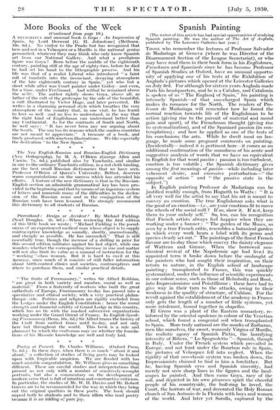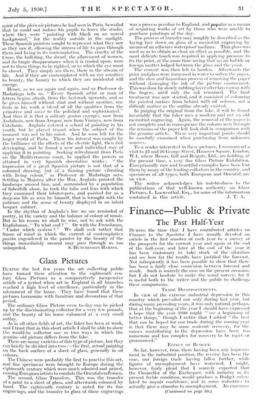Spanish Painting
[The writer of this article has had special opportunities of studying Spanish painting. He was the author of The Art of Anglada, published by The Leicester Galleries last year.]
THOSE who remember the lectures of Professor Salvador de Madariaga at Geneva (where he was Director of the Disarmament Section of the League Secretariat), or who may have read them in their book form in his Englishmen, Frenchmen and Spaniards since he has become Professor of Spanish Studies at Oxford, have an unusual opportu- nity of applying one of his tests at the Exhibition of Anglada's pictures which opened at the Leicester Galleries on July 3rd. For although for sixteen years Anglada made Paris his headquarters, and he is a Catalan, and Catalonia is spoken of as " The England of Spain," his painting is intensely Spanish—of that sun-charged Spain which makes its romance for the North. The readers of Pro- fessor de Madariaga will remember how he found the normal reaction towards life of the Englishman to be action (giving rise to the pursuit of material and moral gain and sport), of the Frenchman thought (giving rise to systematization), and of the Spaniard passion (in con- templation) ; and how he applied as one of the tests of his conclusions the arts. While he dwelt most on lan- guage, he made some pregnant comments on painting. (Incidentally—indeed it is pertinent here—it comes as an additional confirmation of the soundness of his acute and suggestive analysis of words that we have no 'equivalent in English for that word pasion ' • passion is too turbulent, emotion is too volatile ; the Spanish dictionary gives among the first meanings of pa.riciii—while including later vehement desire, and excessive perturbation—" the opposite of action " and " the passive state in the subject.") In English painting Professor de Madariaga can be justified readily enough, from Hogarth to Watts : " It is all very well for the artist to say that his art is meant to convey an emotion. The true Englishman asks what is the good of an emotion—i.e., are your emotions fit to move the wheels of the social mill ? If so, show it. If not, keep' them to your unholy self." So, too, can his recognition that French artists always feel happier when they are working under a banner : " The garden of the Muses, as seen by a true French critic, resembles a botanical garden in which every work bears a label with its genus and species clearly set out." The paintings of the finest French flavour are to-day those which convey the dainty elegance of Watteau and Greuze. When the borrowed neo- classical revival of the Napoleonic age had livel its appointed term it broke down before the onslaught of the painters who had sought their inspiration, on their return to nature, in the English school of landscape painting ; transplanted to France, this was quickly systematized, under the influence of scientific experiments in our colour sense, such as those of Helmholtz and Root, into Impressionisme and Pointillisme ; these have had to give way in their turn to the attacks, owing to their' weakness in the quality of structure, of Cubism. For the revolt against the establishment of the academy in France only gets the length of a number of little systems, yet more intolerant, bound together in chapelles.
El Greco was a plant of the Eastern monastery, re- inforced by the oriental opulence in colour of the Venetian school, which found a congenial soil when transplanted. to Spain. More truly national are the monks of Zurbaran, men like ourselves, the sweet, womanly Virgins of Murillo, the realistic agony of Spanish Pietits, the horrifying intensity of Ribera, " Lo Spagnoletto "—Spanish, though in Italy. Under the French system which prevailed in Europe, and not least under the Bourbon rule in Spain, the pictures of Velasquez fell into neglect. When the rigidity of that neo-classic system was broken down, the Impressionists claimed to find in him a forefather. But he, having Spanish eyes and Spanish sincerity, had merely not seen sharp lines in the figures and the land- scapes he painted. And then came Goya, racy of the soil, and depicted in his own picaresco spirit the cheerful people of his countryside, the bull-ring he loved, the Court, the horrors of war, and decorated the Holy Roman church of San Antonio de la Florida with boys and women_ of the world. And later yet Sorolla, captured by the
suirit of the plein air pictures he had seen in Paris, bewailed that he could not induce his pupils to leave the studio, where they were " painting with black on an unreal background," for the • reality outside in the sunlight. These Spanish painters sought to represent what they saw as they saw it, allowing the stream of life to pass through them and living in its contemplation. The cruelty of the Cross, the bull-ring, the dwarf, the allurement of women, and its tragic disappearance when it is traded upon, were not to them things to be righted, or to which the eye must be closed. They simply arc there, there in the stream of life. And if they are contemplated with an eye sensitive to beauty, the beauty to which they arc incidental will emerge.
Hence, as we sec again and again, and as Professor de Madariaga tells us, " Every Spanish artist or man of letters begins afresh, from the bed-rock upwards, and as he gives himself without stint and without sacrifice, one finds in his work a blend of all the qualities front the primitive and naive to the polished and sophisticated." And thus it is that a solitary genius emerges, now front Andalusia, now from Aragon, now from Vizcaya, now from Catalonia. Anglada entered a school of painting in his youth, but he played truant when the subject of the moment was not to his mind. And he soon left for the larger world of Paris. There his interest was caught-by the brilliance of the effects of the electric light, then fast developing, and he found a new and individual way of applying it in painting. Seeking refreshment from Paris on the Mediterranean coast, he applied the powers so attained in very Spanish decorative works ; " the impression of a great Spanish picture is not that of a coloured drawing, but of a flaming picture vibrating with living colour," as Professor de Madariaga says. Settling in Majorca after the War, Anglada painted the landscape around hint, and, surrounded by a population of fisherfolk alone, he took the tube and lens with which they examined their lobster-pots, and painted for us a deep-sea life as seen by himself, that is wrought with the patience and the sense of beauty displayed in an inlaid lacquer cabinet.
In the rhythm of Anglada 's line we are reminded of poetry, in the variety and the balance of' colour of music. But in his rooms we shall be wise, not to ask with the Englishman, " To what end ? " Or with the Frenchman, " Under which system ? " We shall seek rather that frame of mind in which the current of contemplative pasidn engendered in the painter by the beauty of the things immediately around may pass through its too











































 Previous page
Previous page